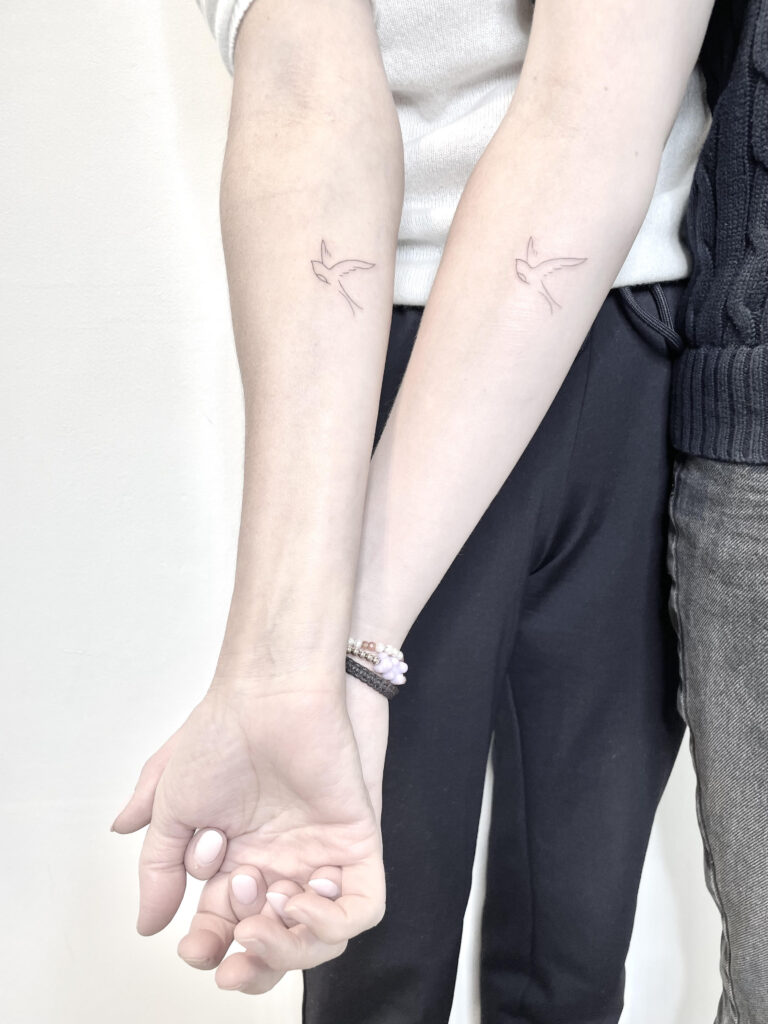You can find all the answers to your tattoo questions here. At Amulett Tattoostudio in Zurich, you not only get a tattoo, but also personalised advice and support during the healing process.
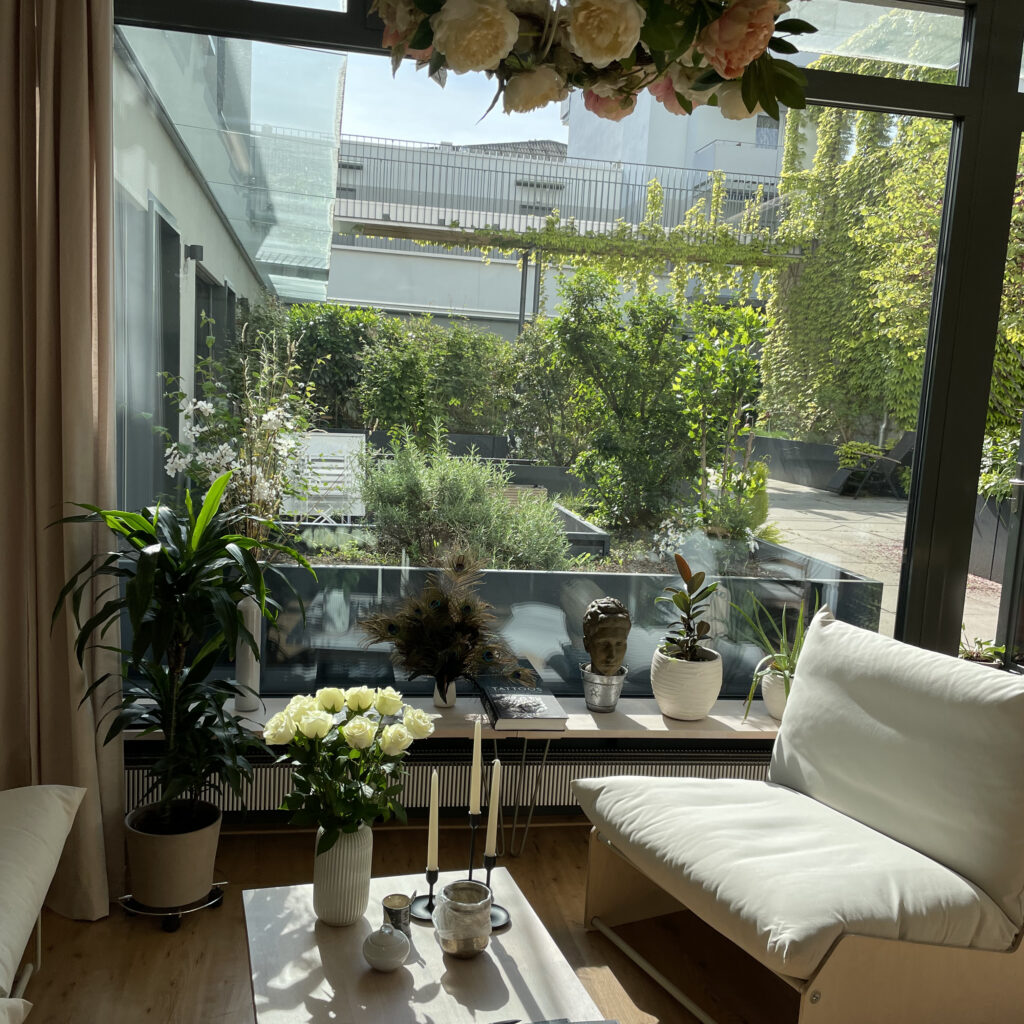
What is special/different about Amulett Tattoo?
There is no time or pressure to perform with me. Each of my tattoos is unique and drawn specifically for you.
Personalised advice, precise adaptation of the motif to the customer’s wishes and support during the healing process are just as much a part of my work as the tattooing itself.
For me, tattooing is a passion and I cultivate a special connection with every customer.
HOW SHOULD I BOOK MY APPOINTMENT?
Do you need an appointment?
Do you have a wish but no finished motif, would you like us to develop it together? Then please send me a few inspirational images: it can be a photo, drawing, ideas… And it is important that you write approximately how big and where you would like it to be.
You can book a consultation appointment in the studio or via video call online here:
Each appointment is free and without obligation, each appointment is confirmed with a deposit. This will be deducted from the final price. In case of cancellation or no-show, the deposit will not be refunded.
Have you already found your dream motif and need a tattoo appointment?
Here are a few tips to help you decide which session is right for your project:
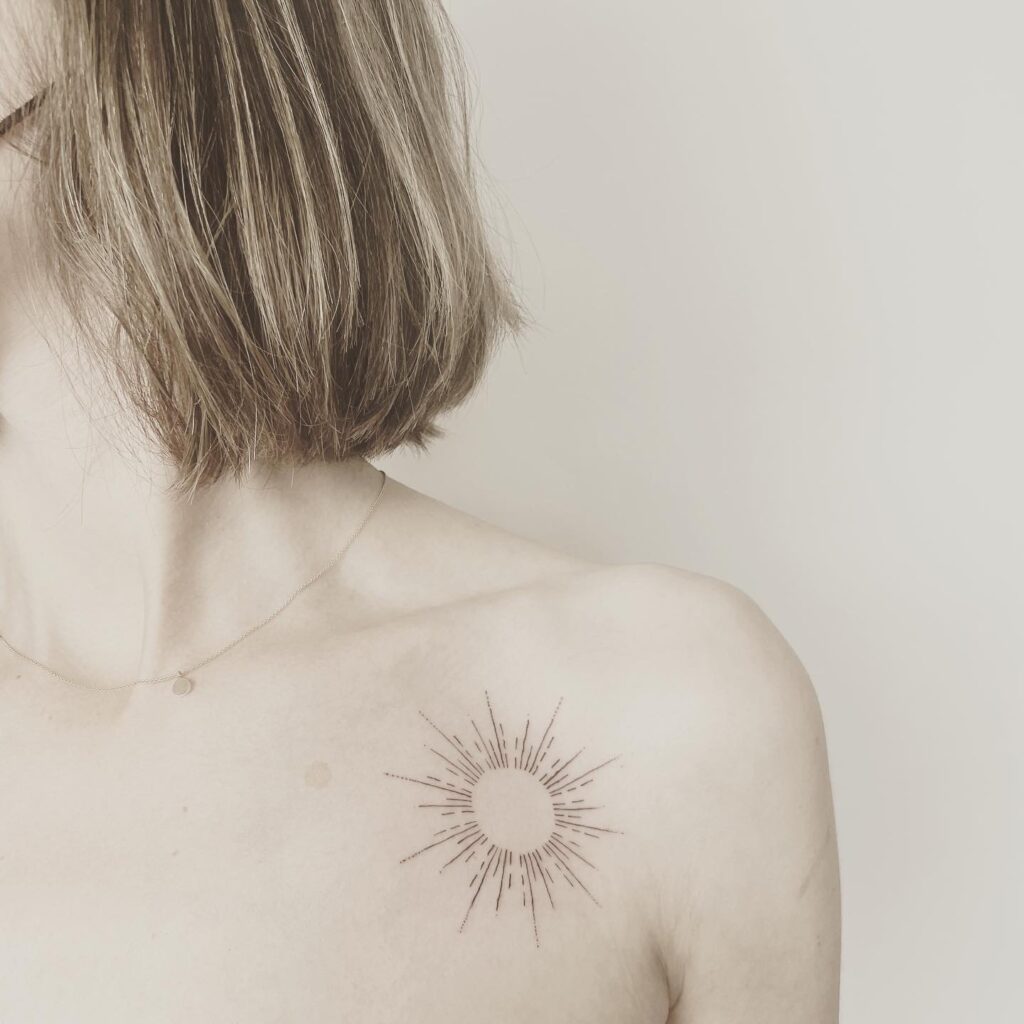
40 min
This session is suitable for small lettering, tiny or mini tattoos. Up to 3 mini tattoos included.
I do my best to make your experience at Amulett as pleasant as possible. That’s why I reserve enough time for you. My philosophy is that everyone feels at home, with enough time and advice (the tattoo will stay, no need to hurry with the decision). In addition, the whole studio is reserved just for you. For all these reasons, the minimum price for a session is 250chf (excl. Taxes) per person. This includes the design, tattooing, drinks during the tattooing, aftercare and touch ups.

1 hour session :
Suitable for palm size fineline, dotwork or oneline tattoos.
For microrealistic palm size tattoo, please book 1 hour 20min.

1 Hour 20 Minuten
Suitable for
Microrealistic up to palm size tattoo and for up to 10cm length finelines, dotwork,
ornamental or oneline tattoos.
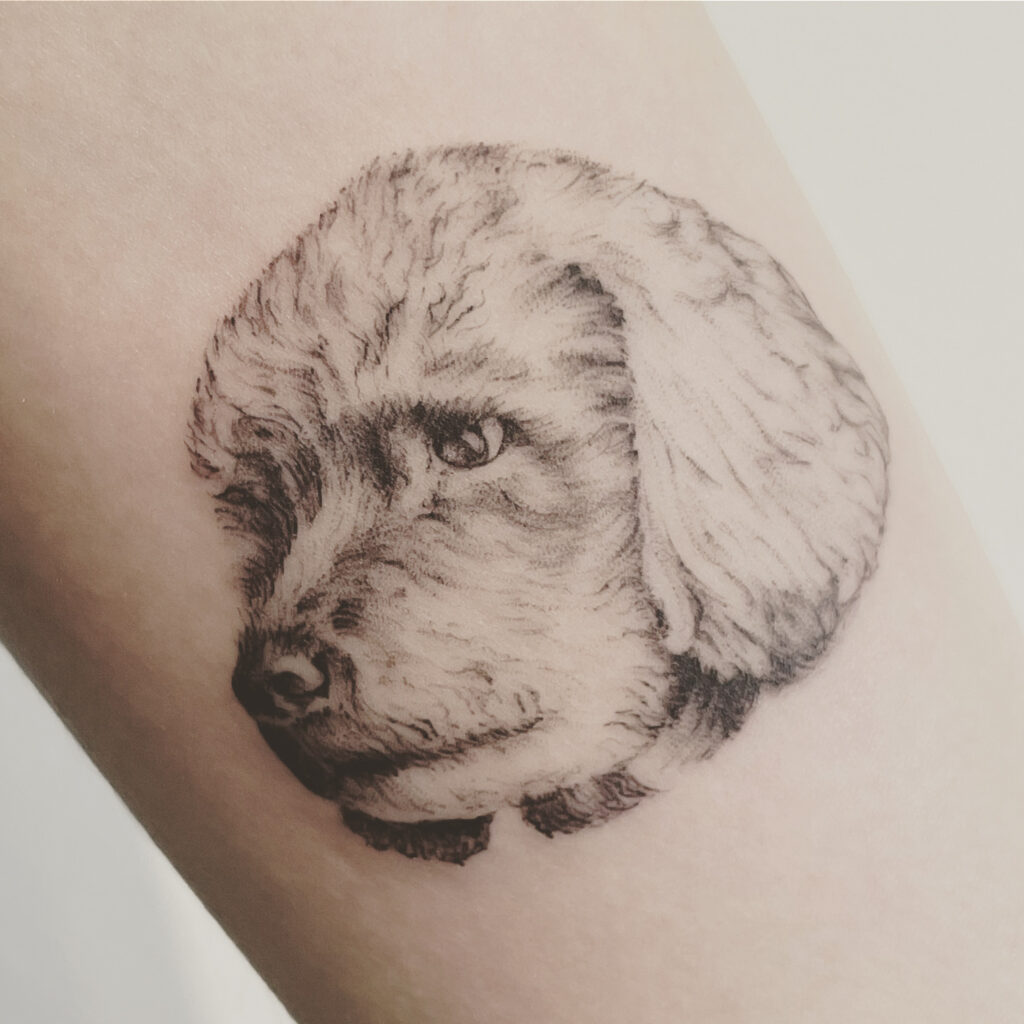
1 Stunde 40 Minuten Session
Suitable for
7.5 to 10cm diameter microrealistic tattoos.
10 cm to 14 cm long finelines, dotwork or oneline tattoos.

2 Hours
This 2 hours session is suitable for freehand projects such as thigh, calf, shoulders, upper arm/lower arm outside/inside.
It is also suitable for stencil templates with complex compositions in finelines, dotwork or microrealism.
Up to an A5 surface.
(A5 is A4 sheet folded once . 14.8 cm x 21 cm)
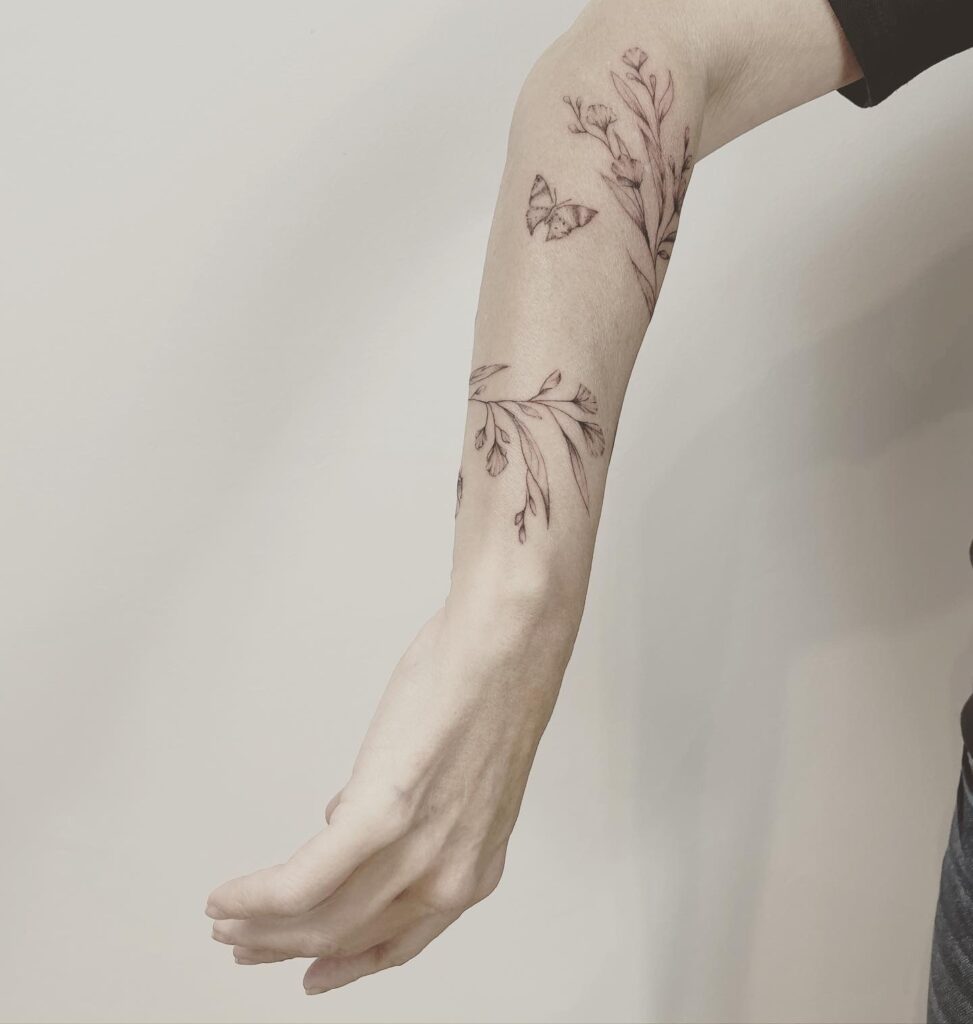
2 Hours 20 Minuten
PLEASE BOOK AN APPOINTMENT FIRST FOR LARGER PROJECTS (IN STUDIO OR VIA VIDEOCALL)
Suitable for
-Bracelet around the arm (freehand floral bracelet or black single / double band)
-forearm inside or outside, upper arm inside or outside.
2 Hours 40 Min
PLEASE BOOK AN APPOINTMENT FIRST FOR LARGER PROJECTS (IN STUDIO OR VIA VIDEOCALL)
Suitable for for example
-Bracelet around the leg, (freehand floral bracelet or black single / double band)
-inner or outer thigh, inner or outer thigh.
- Rib tattoo up to A5 size with lots of details
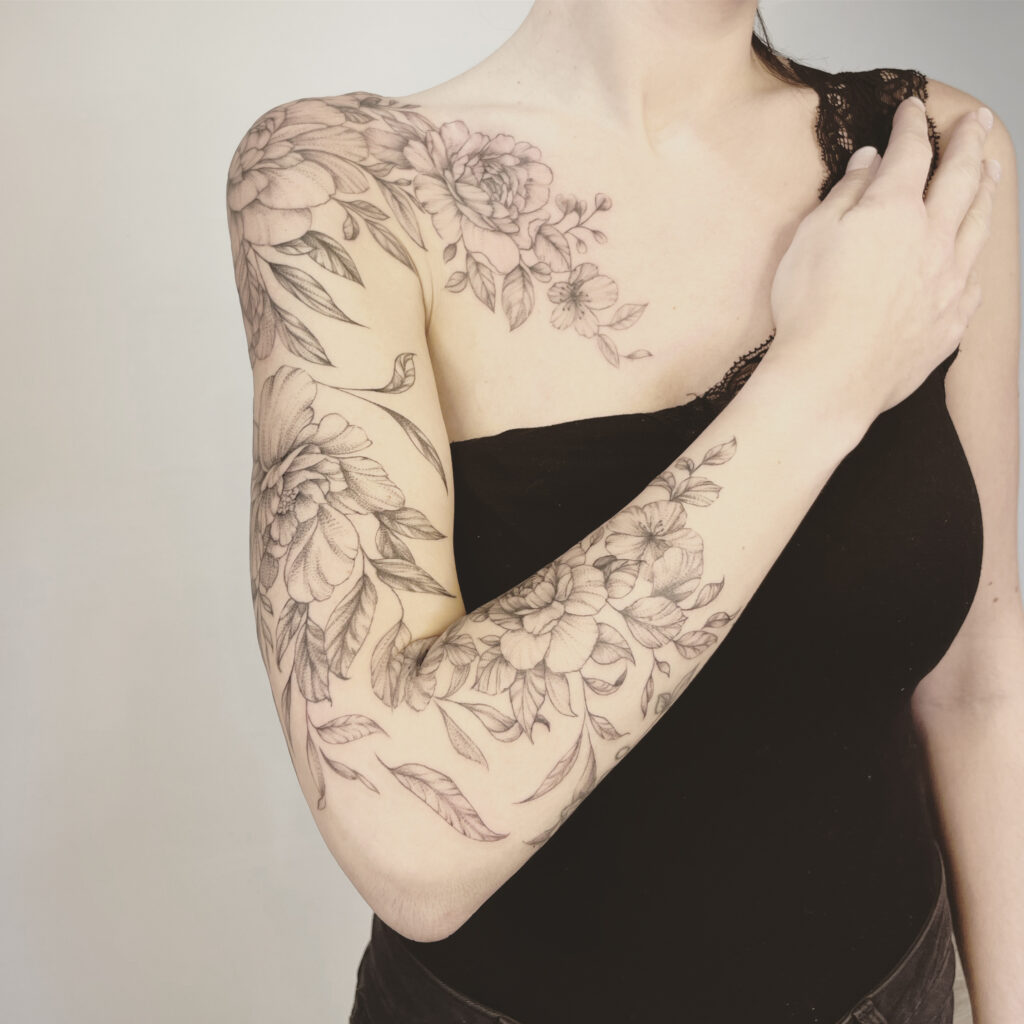
3 Hours
PLEASE BOOK AN APPOINTMENT FIRST FOR LARGER PROJECTS (IN STUDIO OR VIA VIDEOCALL)
4 Hours
PLEASE BOOK AN APPOINTMENT FIRST FOR LARGER PROJECTS (IN STUDIO OR VIA VIDEOCALL)
If you are not sure which session you need for your tattoo, please send me a picture of where and how big you want it via Whatsapp thanks to the green button at the bottom right or by email. This way we can quickly arrange a tattoo appointment.
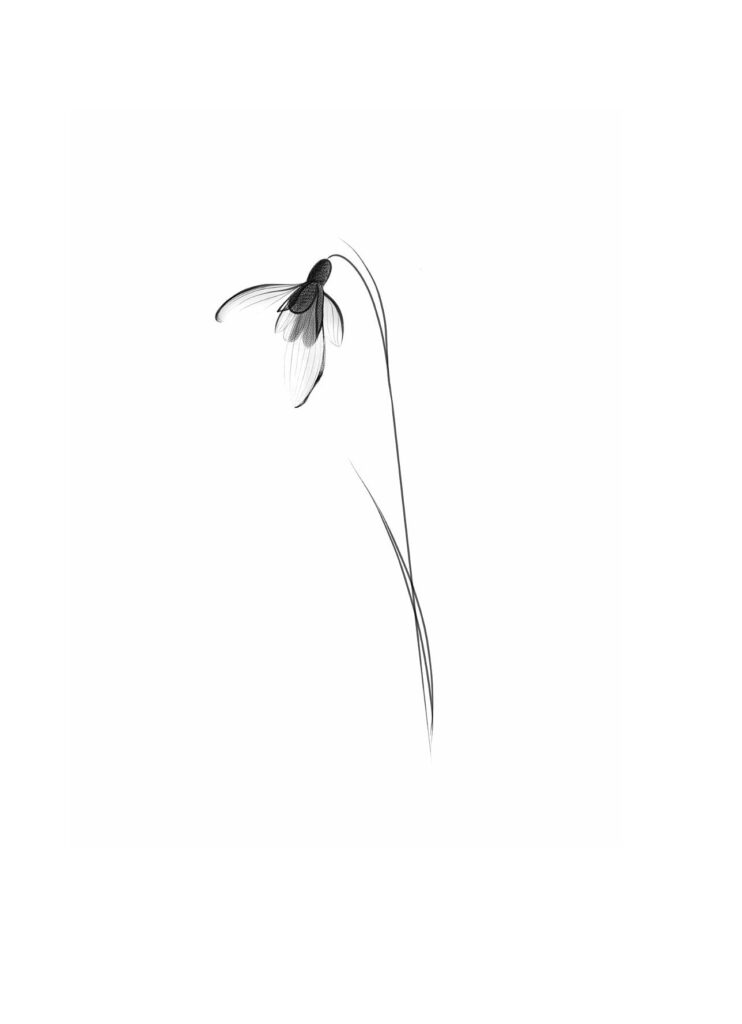
WHAT TO CONSIDER BEFORE THE APPOINTMENT.
How do I prepare for my tattoo appointment?
- Avoid alcohol the evening before and get enough sleep.
- Drink and eat enough before your appointment to get your circulation going.
- Wear black clothing (risk of staining)
- Make sure that your clothes fit loosely and do not rub against the freshly tattooed area.
I look forward to seeing you!
What is a deposit and why do I have to pay it?
The deposit (from 100CHF to 240 CHF depending on the duration of the session) is intended to ensure that the appointment is not forgotten. In case you don’t show up, it is also a small compensation for the lost time.
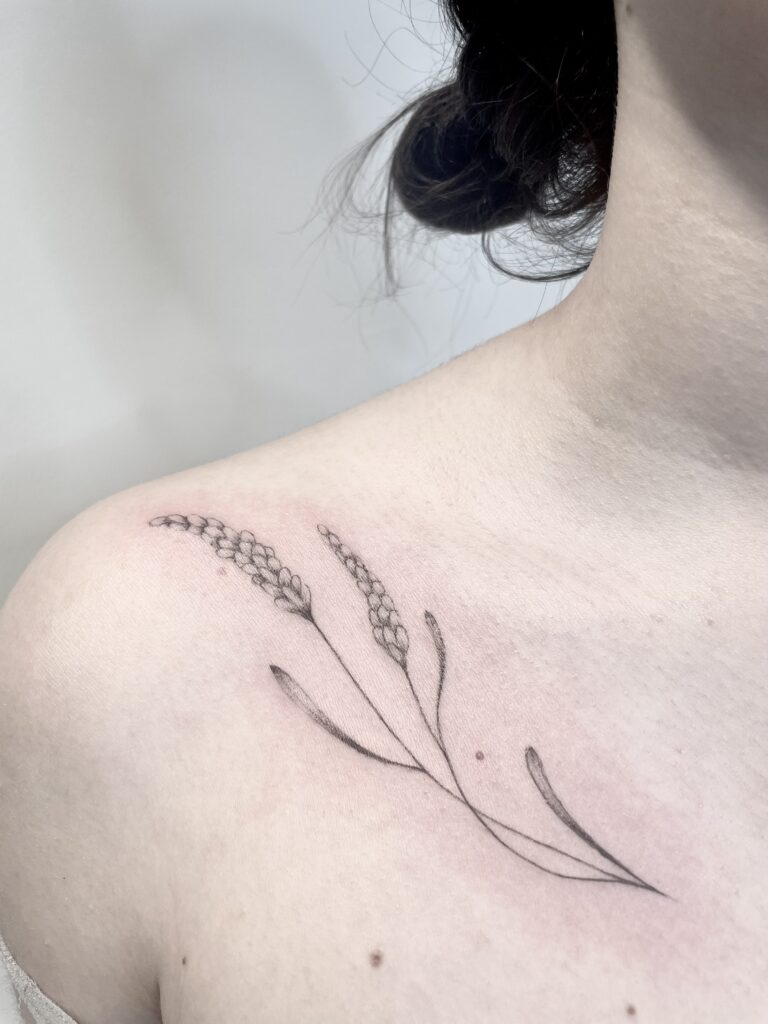
How much does a tattoo cost at Amulett Tattoo?
The prices are calculated according to the effort, size and preparation time of the motif. The preparation work of the motif and the materials used are already included. Please remember that you will be wearing this work of art for the rest of your life! Don’t you want it to be luxurious and perfect? If you have a limited budget, do fewer tattoos, but do quality ones, in the end a cheap tattoo will be too expensive (laser prices can be up to five times more expensive than regular tattoo prices). I will give you a price range at our appointment after we have decided on the size, placement and design of your tattoo.
I do my best to make your experience at Amulett as pleasant as possible. That’s why I reserve enough time for you. My philosophy is that everyone feels at home, with enough time and advice (the tattoo will stay, no need to hurry with the decision)
For all these reasons, the minimum price for a session is 250chf (excl. VAT) per person. This includes design draft, tattooing, drinks during the tattooing and after-stitching.
I am at your disposal during the entire healing process and you can reach me at any time. It is very important to me to accompany you to offer you the best service and the best experience around your tattoo.
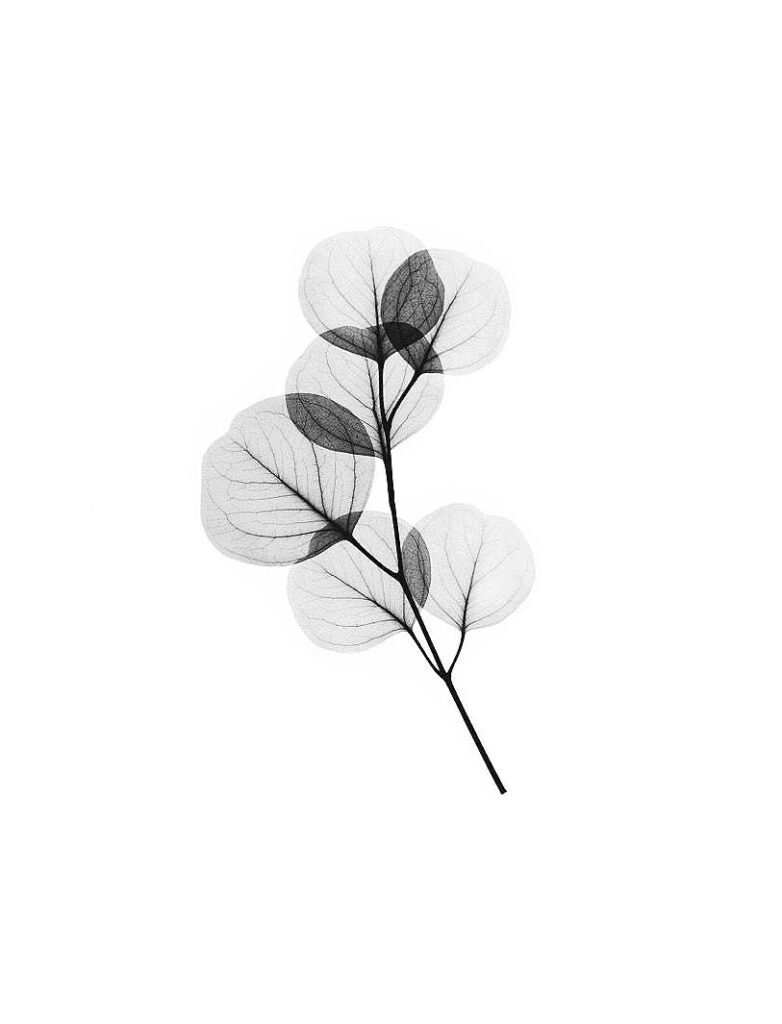
EVERYTHING ABOUT THE HEALING PHASE
How long does the healing phase take?
The healing phase of a tattoo can vary depending on size, complexity, placement and individual healing abilities. In general, however, it takes about 2 to 3 weeks for the outer layer of the skin to heal. During this time, the skin may be red, swollen and sensitive. The formation of crusts or scabs is also common while the skin heals.
It is important to follow your tattoo artist’s instructions for aftercare to ensure proper healing. This usually includes washing the tattoo regularly with mild soapy water, applying a thin layer of a suitable ointment or lotion to moisturise the skin and avoiding direct sunlight and excessive rubbing of the tattoo.
Although external healing can take place in a few weeks, it can take several months for the deeper layers of the skin to heal completely and for the tattoo to reach its final colour and texture. During this time, it is important to protect the tattoo from sun exposure and keep it moisturised to maintain the health of the skin and the colour intensity of the tattoo.
What should I bear in mind when healing my tattoo? How should I care for it?
You can read the hAfter-care instructions here
here you can find out more about the Swiss Tattoo Association VST
What is a touch-up session and do I even need it?
At Amulett Tattoo we ensure a perfect result. Depending on the healing process and skin type, some lines may need to be touched up within a month after tattooing. Fineline tattoos are very demanding, which is why re-stitching is included in the price.
However, not every tattoo needs a touch-up appointment. If you are unsure, you can send us a photo and we will be happy to advise you.
We can also re-stitch or refresh other people’s tattoos, but at the normal rate.
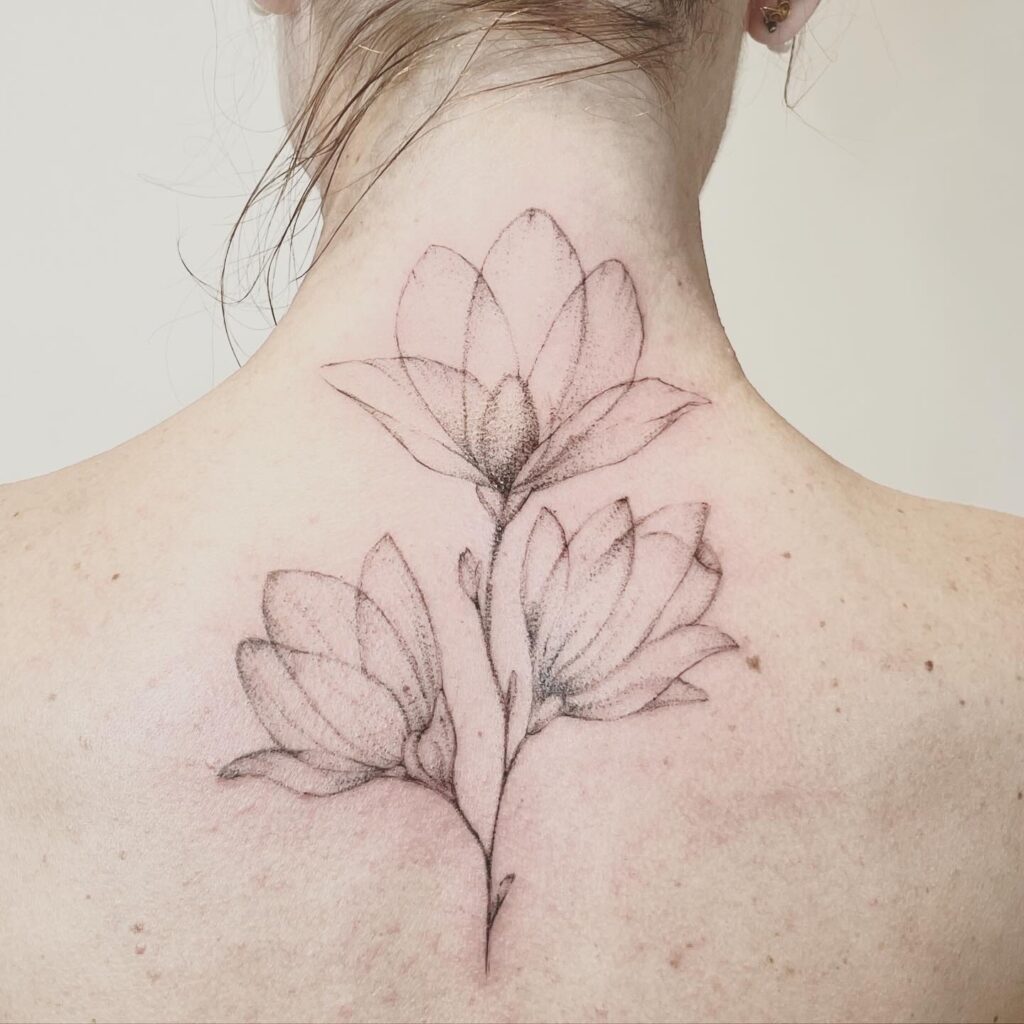
When should I come back for a touch-up and do I even need it?
Re-stitching takes place within a maximum of 2 months after your appointment with us. Each follow-up appointment is offered once, in case of a no-show or a cancellation at short notice, this appointment is cancelled and will be charged normally the second time.
Of course there is also the possibility to have other tattoos or amulet tattoos that are older than 2 months re-engraved for a fee.
ALL ABOUT TATTOOS
What is a freehand tattoo session and how is it created?
In this video, you can discover the different stages of the freehand process.
Can I have laser hair removal on my tattoo?
UNDER NO CIRCUMSTANCES !!!! Laser hair removal is ABSOLUTELY taboo on tattoos! If your beautician does not inform you about this and uses a laser on your tattoo, you should change beauty salons.
In the case of a tattoo damaged by laser hair removal, you will be charged for re-stitching.

Which tattoo suits me?
The world of tattoos has expanded and refined enormously over the last 10 years. Many styles have emerged: Dotwork, finelines, ornamental, etc… At Amulett Tattoo, my heart beats for elegant, thin and discreet tattoos. I believe that ‘less is more’ and that tattoos can also look very chic. With me you have the possibility to fulfil your wish. No matter how big, I will never talk you into your decisions.
To find out which tattoo suits you best, look for some inspiration on the internet. That way we can discuss together which style suits you best.
Here you will find more inspirations.
Where should I get my first tattoo?
This choice is completely up to you! For the reasons mentioned above, I would advise you not to choose a place that is too obvious for your first tattoo. The upper arm, thigh or calf, on the other hand, are very suitable places to take your first step into the big world of tattooing.
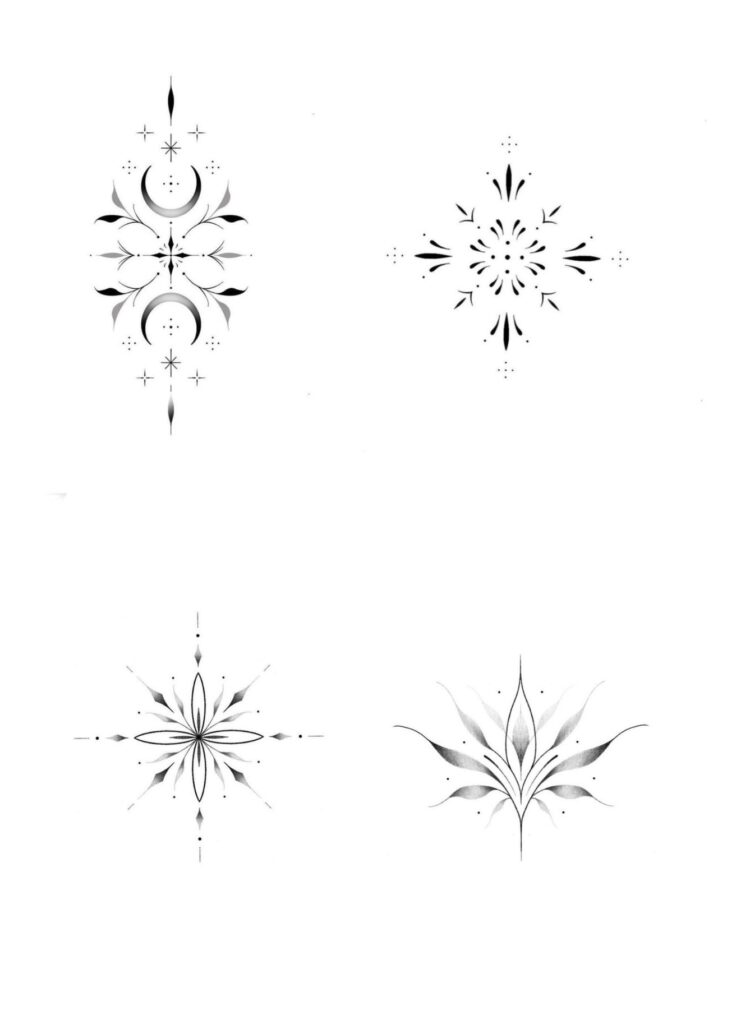
Why should my tattoo have a minimum size?
Depending on the placement and skin type, you should make sure that the design is not too small so that it does not grow together over the years. I will be happy to advise you.
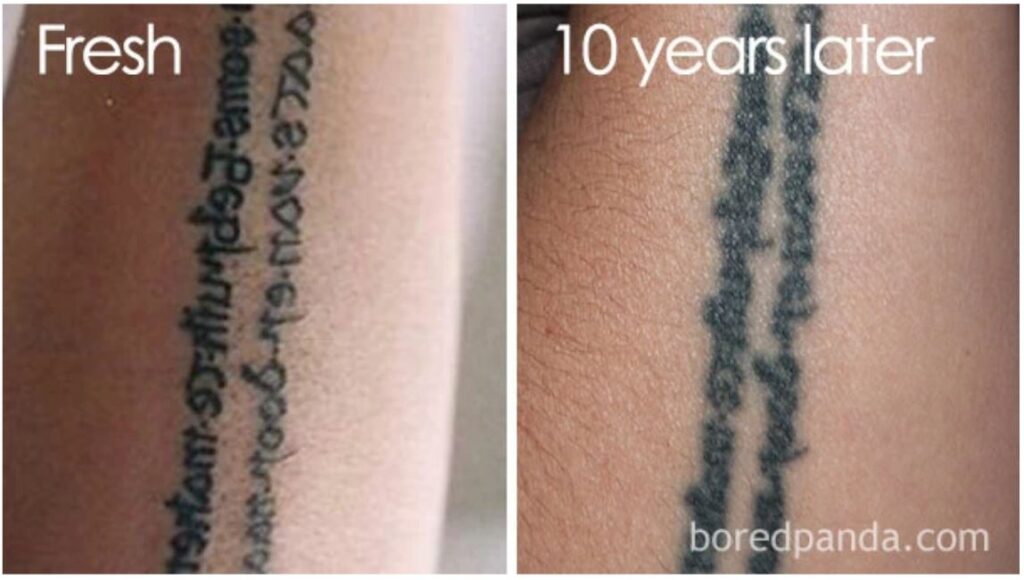
Why are tattoos on the hands or face tricky and what do you need to bear in mind?
Tattoos on the face, hands and neck are always visible and are as popular as they are criticised. But how can you be sure that you are ready for these areas? Because then, hiding them is no longer an option… In addition to worrying about how your environment will react, the following question also arises: How does it feel? How does it feel to make this decision and to realise the desire to wear a highly conspicuous tattoo on your body forever? You can only see whether you can handle the criticism once the tattoo is under your skin.
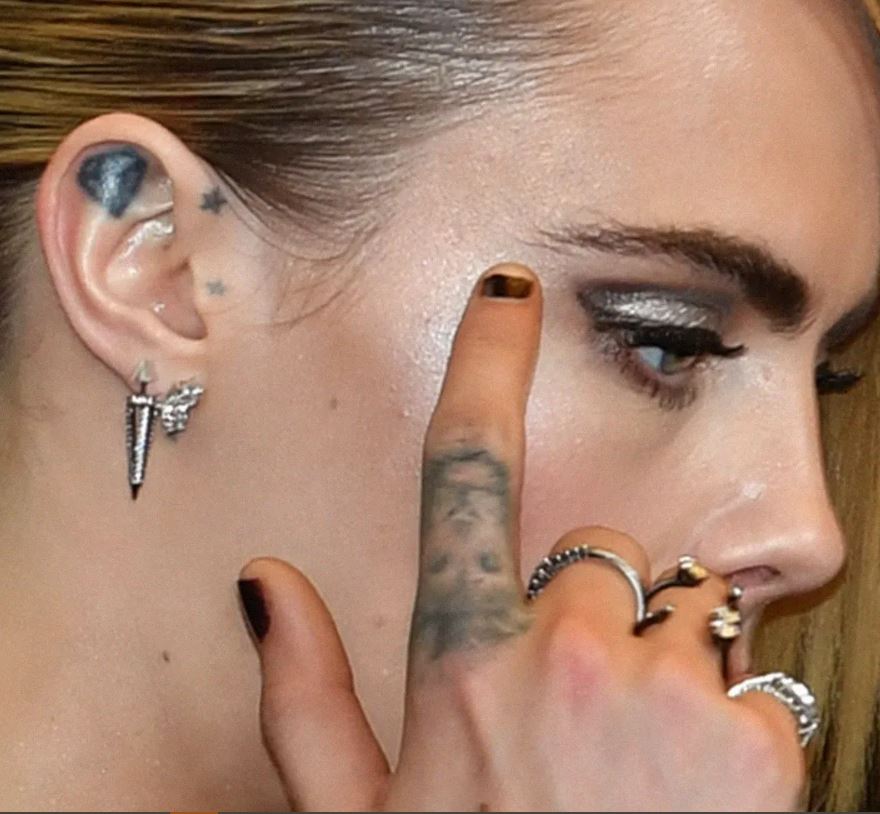
In addition, these areas come into contact with sunlight more often or are rubbed off more, as on the hands. These tattoos therefore age faster than on other areas. On the fingers, the tattoo almost always has to be re-pierced and the risk of the tattoo running is significantly higher than elsewhere. The prospect of a long-lasting, beautiful tattoo is significantly lower. I would generally advise you not to choose such areas for your first tattoo.
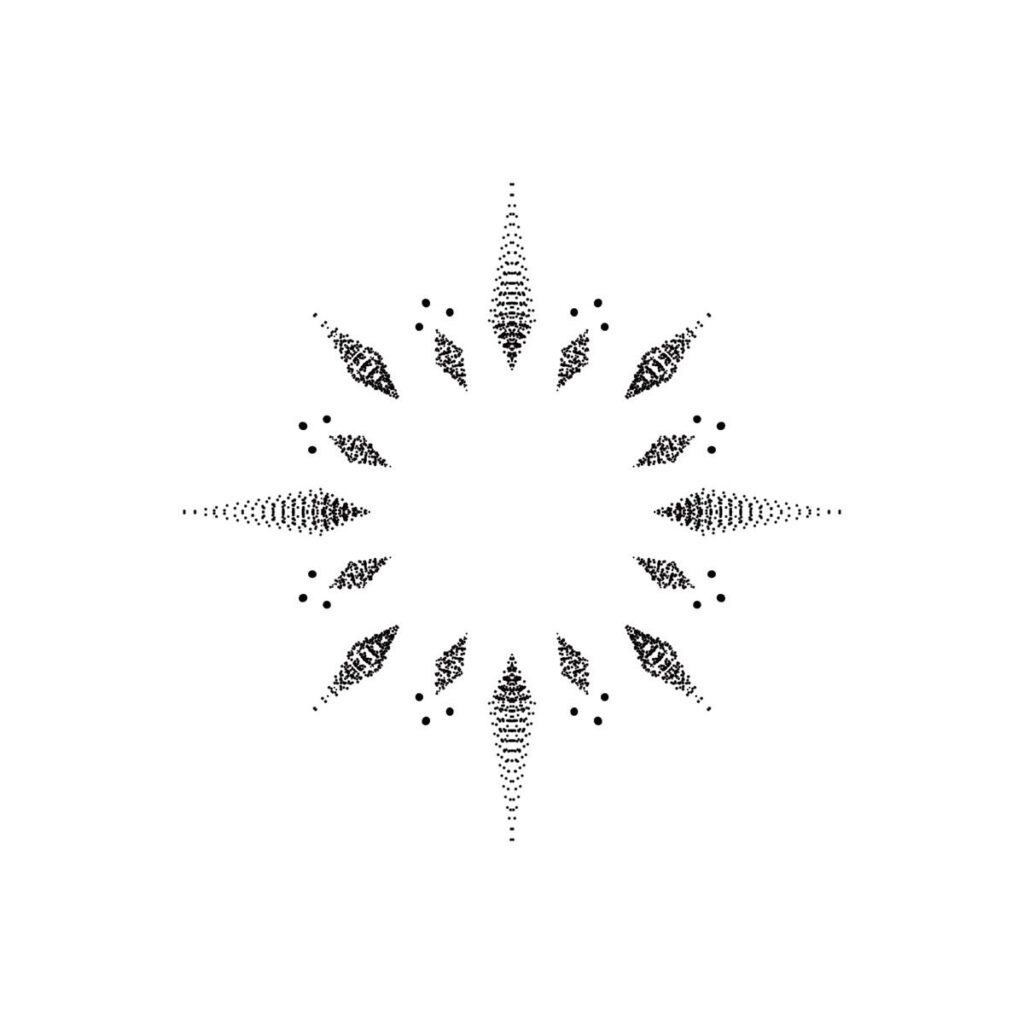
ALL ABOUT HYGIENE AND RESPONSIBILITY
Why am I not allowed to bring pets to the appointment?
For hygienic reasons it is not recommended to have a pet in the room. Some people may also have allergic reactions.
Why should I notify you if I want to bring a companion to the appointment?
The Amulett Studio is small and cosy. This means that only a limited number of people can fit in. I therefore ask you to come unaccompanied if possible or to inform me if you cannot do otherwise. This way I can ensure that everyone feels comfortable and I can concentrate on my work (or your tattoo).
I am under 18 years old, can I still get a tattoo?
If you are between 16 and 18 years old, you should bring me your ID and a signed written authorisation from one of your parents before the appointment. This authorisation must include the following:
- A copy of the ID of one of your parents
- The telephone number of one of your parents
- A precise description of the tattoo motif, the size and the intended body part
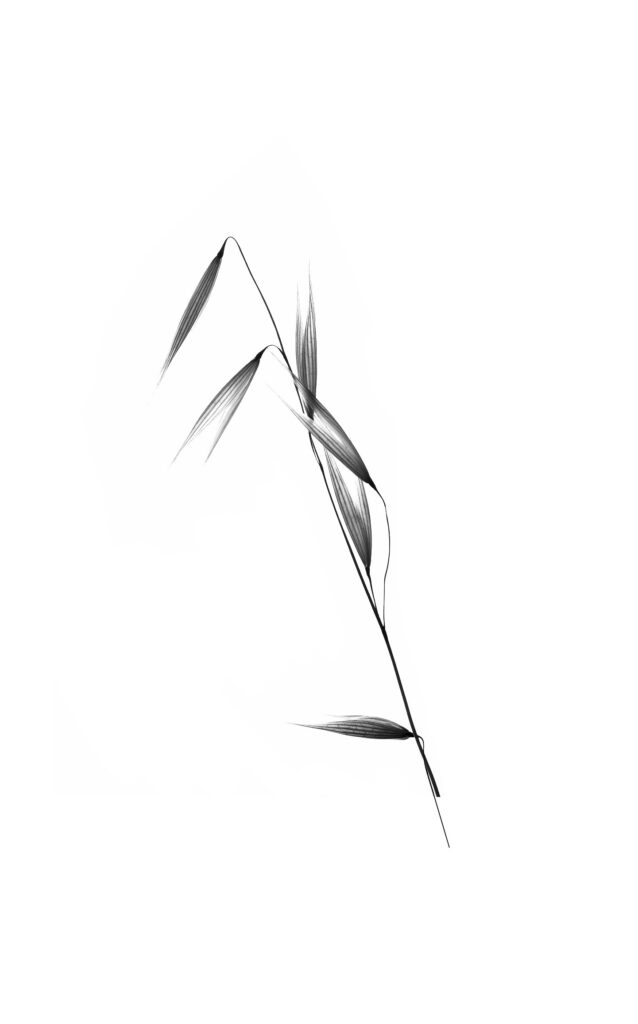
Which inks and products are used at Amulett Tattoo?
Only vegan and high-quality products are used at Amulett. I attach just as much importance to the quality of the products as I do to the tattooing and the company of my customers.
You can find out more about the hygiene rules here
Is it possible to have an allergic reaction to tattoo ink?
Yes, it is possible to have an allergic reaction to tattoo ink. Some people may have allergic reactions to certain ingredients in tattoo ink, such as certain colourants or preservatives. Symptoms of an allergic reaction can include redness, itching, swelling or a rash at the site of the tattoo. In some cases, the symptoms can be more severe and require medical treatment. It’s best to discuss this with your doctor before your tattoo appointment. If you suspect that you are allergic to tattoo ink, it is important to see a doctor who can help you further.
If you are allergic to nickel or chromium VI, please inform me beforehand as these ingredients can cause allergic reactions.
What is the new EU regulation on tattoo inks?
10.01.2024: In Switzerland, legal requirements for tattoo and permanent make-up inks have been laid down in the Ordinance on Articles for Human Contact for several years (Verordnung über Gegenstände für den Humankontakt). These are based on a resolution of the Council of Europe and regulate the use of substances in such inks. Substances of particular concern, such as those with proven carcinogenic properties, are already banned as a result. In the EU, the current Regulation (EU) 2020/2081 (Verordnung (EU) 2020/2081) introduced a new regulation on chemicals legislation. Switzerland has largely adopted this regulation with the current revision of the HKV. These new requirements for tattoo inks come into force on 1 February 2024 and a transition period of one year applies.
You can find out more on the Federal Food Safety and Veterinary Office website here
In principle, coloured tattoos are also feasible for amulet tattoos, and are offered depending on the designs and customer requirements.
However, due to the fading and ageing of coloured ink, we tend to advise against getting coloured tattoos.
How painful is it to get a tattoo? Can I use anaesthetic cream?
The intensity of the pain depends on the body part and the duration of the tattoo. The longer, the more painful, the more sensitive the skin, the more painful…
Any kind of anaesthetic cream is not used for Amulett Tattoo. According to the Swiss Tattoo Association, they carry a high risk of allergies or severe skin reactions and are therefore taboo.
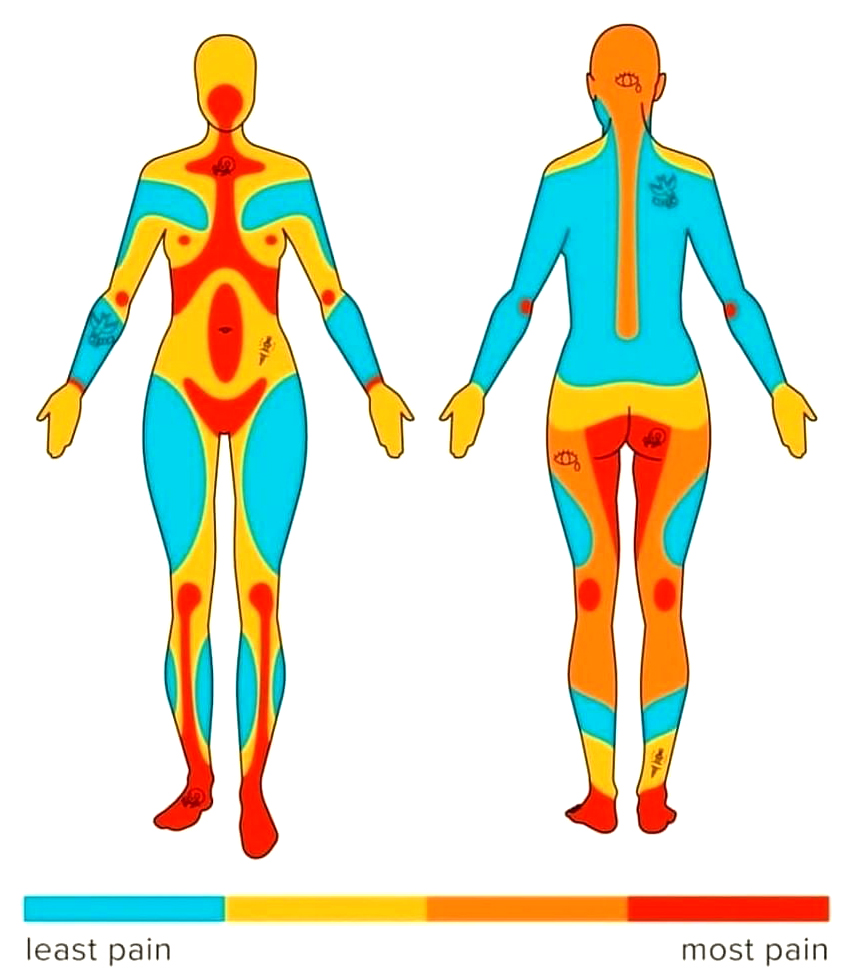
Anaesthetic cream requires a prescription in Switzerland. According to the Swiss Tattoo Association, its use is not recommended. To rule out complications (skin reaction, allergy…), we therefore do not use anaesthetic cream at Amulett Tattoo.
Please do not use it yourself before your appointment.
Why are there no black light tattoos at Amulett?
At Amulett Tattoo, we only use products authorised for use on the Swiss market. The food regulations governing tattoo products are very strict in Switzerland. They ensure that customers are protected from carcinogenic pigments or other chemical components.

Why should I turn up for my appointment sober and why am I not allowed to drink alcohol 24 hours before the prick?
Alcohol and drugs affect the body’s fluid balance. If this is disturbed, your tattoo may not be as beautiful. Your blood will become thinner and the tissue softer. These are not ideal conditions for a beautiful tattoo. In addition, you should turn up to your appointment with all your strength and full of energy.
I am pregnant or breastfeeding, can I get a tattoo?
To avoid any complications, I advise you not to get a tattoo while you are pregnant or breastfeeding. However, we can create your tattoo motif during this time so that it is ready when you are ready.
Why is there no student discount at Amulett Tattoo?
A tattoo is never harmless. It is important to be sure of your choice and really think it through before getting a tattoo.
It’s not a consumer good that you buy at a discount or on sale.
A tattoo affects your health and will permanently change a part of your body.
I work very strictly and only use high-quality products and inks. Of course, all this comes at a price, so I favour people who value quality.
If the price of a tattoo seems too high, I advise you to think about it and save up to be able to afford a high-quality tattoo. An unprofessionally engraved tattoo that does not comply with hygiene regulations can have serious consequences for your health.
It should therefore not be taken lightly. After all, a tattoo is always cheap when you consider that you pay once to have it for life (what product has such a long lifespan these days?).

EVERYTHING ABOUT COVER-UP / TATTOO UPGRADE
What can I do if I no longer like my tattoo or if it is no longer so beautiful after 20 years?
There are several solutions,
- A laser can be used to remove the tattoo permanently (e.g. in the case of a youthful mistake or a break-up). Please note that the pain and the price are much higher than with a tattoo. The final result also depends on the quality of the tattoo: A tattoo that is too deep will leave scars or cannot be completely removed at all.
- Refreshing an old tattoo. After a few years, the pigments of the tattoo age and lose their luminosity, so it is possible to refresh them to give them a fresh coat of paint. This option is very suitable for the fineline style, as you can refresh a tattoo after 10 to 15 years without weighing it down.
- Cover-up is a technique in which the old tattoo is covered by a new one to make it disappear. When you type in cover-up on the internet, you may be frightened by the massive and heavy nature of most cover-ups. It is not absolutely necessary to fill the entire area.
- And depending on the tattoo to be covered, you can find light and airy alternatives. With Amulett Tattoo, the philosophy is to cover as little as possible in order to make the old tattoo disappear without having to resort to the heaviness and massiveness of classic cover-ups. I always try to find a gentle solution, but this is not always possible. Please also note that the cover-up must be at least twice the size of the tattoo to be covered (ideally three times) For any cover-up project, you are welcome to contact me and arrange a consultation.
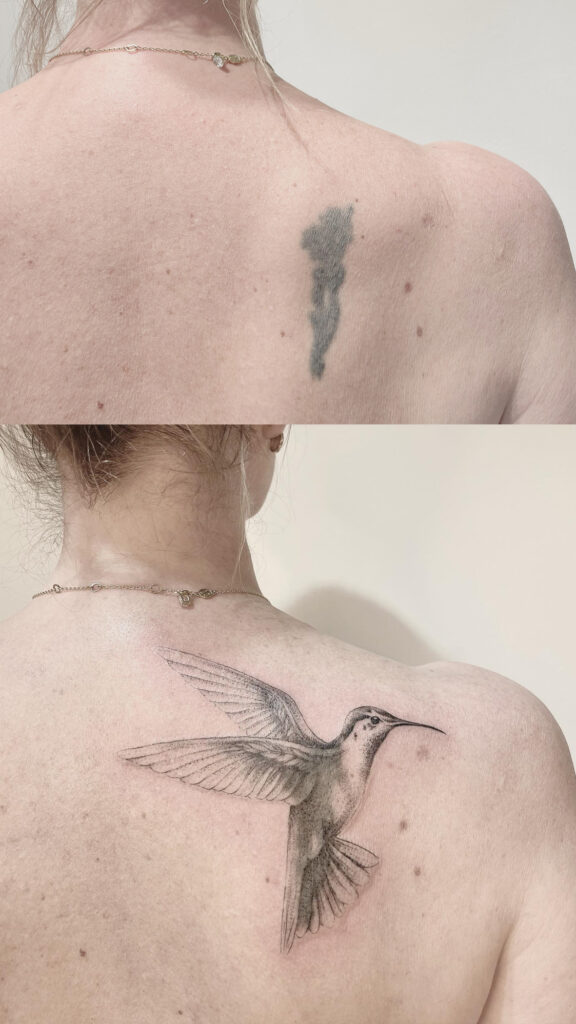
What is a cover-up tattoo?
A cover-up tattoo is a tattoo designed to cover up or cover over an existing tattoo. People often opt for a cover-up tattoo to hide an old tattoo that they no longer like or that no longer represents them. This type of tattoo often requires special planning and design to effectively cover up the old tattoo. An experienced tattoo artist will analyse the old tattoo and create a new design that completely covers the old tattoo while being aesthetically pleasing. Cover-up tattoos can include a variety of styles and motifs, depending on the client’s preferences and the tattoo artist’s skills.
Discover more about Cover up Here
Do you need to laser the tattoo before you can do a cover-up?
It depends on various factors whether laser tattoo removal is required for a cover-up tattoo:
- Opacity of the new tattoo: a cover-up tattoo should completely cover the old tattoo. However, if the old tattoo has dark, intense colours or complex details, it may be difficult to cover it up effectively without it showing through the new tattoo. In such cases, laser tattoo removal can help to fade the old tattoo and improve the opacity of the new tattoo.
- Size and placement of the old tattoo: If the old tattoo is small and the new tattoo is large enough to cover it completely, laser tattoo removal may not be necessary. However, if the old tattoo is large or in a prominent location such as the face or hands, laser pre-treatment can help to fade the colours and make the cover-up more effective.
- Desired design of the new tattoo: Some designs can easily integrate or utilise the old tattoo, while others require a smooth surface. Depending on the desired design of the new tattoo, laser tattoo removal may be required to remove or fade the old tattoo to make room for the new
Es ist wichtig, mit einem erfahrenen Tattoo-Künstler zu sprechen, der Erfahrung mit Cover-up-Tattoos hat. Sie können das alte Tattoo bewerten und Empfehlungen geben, ob eine Laser-Tattooentfernung vor dem Cover-up erforderlich ist, um die besten Ergebnisse zu erzielen.

ALL ABOUT TATTOO REMOVAL
Can a tattoo be removed completely?
Yes, there are different methods to remove a tattoo if someone decides to get rid of it. The most common methods are:
- Laser removal: this is the most common method of removing a tattoo. Special lasers are used to shatter the colour pigments in the tattoo, allowing the body to break them down via the natural healing process. This method requires several sessions to achieve optimal results and can be somewhat uncomfortable.
- Surgical removal: For small tattoos, a surgeon can surgically cut out the tattoo and then stitch up the skin. This method can leave scars and is not usually the preferred method for larger tattoos.
- Dermabrasion: In this method, the top layer of skin containing the tattoo is abraded. This technique is a painful procedure and can leave scars. It is not recommended.
It is important to note that none of these methods guarantee that the tattoo will be removed completely and without scars. The effectiveness and risks vary depending on the size, colours, age and type of tattoo as well as individual skin types. It is advisable to seek advice from an experienced dermatologist or dermatologist before deciding on a removal method.
How does laser tattoo removal work?
Laser tattoo removal works by using high-energy laser beams to shatter the colour pigments in the tattoo. When the laser beam hits the skin, the colour pigments in the tattoo are absorbed and broken down into smaller particles. These particles are then broken down by the body’s immune system and removed via the natural healing process.
Source of the video : dispelyourtattoo.ch
Does tattoo removal hurt much more than tattooing?
The sensation of pain during laser tattoo removal can vary from person to person and depends on several factors, including individual pain tolerance, the location of the tattoo and the size of the tattoo. In general, the pain sensation of laser tattoo removal is often described as comparable or slightly more intense than tattooing. Here are some reasons why:
- Concentrated energy: The laser emits high-energy flashes of light that target the pigment in the skin to shatter it. This can be felt as an intense sensation of heat or stinging pain, especially in sensitive areas of the skin.
- Repeated treatments: Laser tattoo removal usually requires multiple sessions, several weeks apart, to achieve optimal results. During each treatment cycle, the skin may become more sensitive, which can lead to an increased sensation of pain.
- Skin sensitivity: Depending on skin type and sensitivity, the pain sensation during laser tattoo removal may vary. People with sensitive skin may find the treatment more uncomfortable.
- Aftercare: After laser tattoo removal, the treated skin may be reddened, swollen and sensitive. This can lead to persistent discomfort that may last for a few days after the treatment.
It is important to note that many people can tolerate the pain of laser tattoo removal well, especially if it is performed with the right pain relief techniques, such as local anaesthetic or cooling. It is advisable
What kind of tattoo removal devices are there?
There are different types of lasers that are used for tattoo removal, including
- Q-switched Nd:YAG laser: This is one of the most common lasers used for tattoo removal. It emits short, high-energy flashes of light that specifically target the colour pigments in the tattoo.
- Alexandrite laser: This laser is effective for black and blue tattoos, but can also remove other colours.
- Picosecond laser: This is an advanced form of Q-switched laser that uses ultra-short pulses in the picosecond range to destroy the colour pigments even more efficiently.
The choice of the appropriate laser depends on various factors, including the colours of the tattoo, the patient’s skin colour and other individual characteristics. Before treatment, the skin is cleansed and often an anaesthetic cream is applied to minimise pain. There may be a mild to moderate sensation of pain during the treatment, which can be minimised with a cooling system or cooling airflow.
Laser tattoo removal usually requires several sessions spaced several weeks apart to achieve optimal results.
Laser tattoo removal usually requires several sessions spaced several weeks apart to achieve optimal results. The number of sessions required depends on various factors, including the size, colours and depth of the tattoo, as well as the body’s individual response to the treatment.
Why is tattoo removal so expensive?
The cost of tattoo removal can vary depending on various factors, but here are some reasons why it is often considered expensive:
- Technological investment: most high-quality tattoo removal practices use specialised laser equipment that is expensive and requires regular maintenance. This technology is necessary to achieve effective results and minimise the risk of complications.
- Training and expertise: Performing safe and effective tattoo removal requires specialised training and expertise. Those performing tattoo removal must familiarise themselves with how the lasers work, know the appropriate settings for different skin types and tattoo colours and understand the risks and side effects of treatment.
- Treatment time and sessions: Most people require multiple sessions to completely remove a tattoo. Each session requires time to prepare the skin, perform the treatment and provide aftercare. The number of sessions required depends on several factors, including the size, colours and depth of the tattoo, as well as the individual body’s response to the treatment.
- Cost of running the practice: As with any medical or cosmetic practice, there are also costs for rent, insurance, administrative tasks and staff that need to be factored into the overall cost of the treatment.
- Risks and liability: A professional tattoo removal practice carries a certain risk of side effects such as scarring, pigment changes or infections. Prices often also reflect the cost of adequate liability insurance to provide protection in the event of complications.
Overall, the cost of tattoo removal is often justified by the high-quality equipment, the expertise and training of the staff, and the risks and time required for effective treatment.
How many tattoo removal sessions does it take to lighten a tattoo?
The number of tattoo removal sessions needed to lighten a tattoo depends on several factors, including the size and colours of the tattoo, the depth of the tattoo, the patient’s skin type and the desired lightening. In general, lightening a tattoo requires fewer sessions than complete removal, but it is difficult to predict an exact number of sessions as each case is individual.
Lightening a tattoo often requires fewer sessions than full removal, as the aim is to reduce the intensity of the colours rather than remove them completely. However, depending on the colours and depth of the tattoo, several sessions may still be required to achieve the desired result.
The number of sessions required is usually discussed at the initial consultation with the treating doctor or dermatologist, who can assess the tattoo and create a personalised treatment plan. During the course of treatment, progress will be monitored and the number of sessions adjusted accordingly to achieve the best results.
How many tattoo removal sessions does it take to get a tattoo completely removed?
The number of sessions required to completely remove a tattoo can vary greatly and depends on several factors:
- Size of the tattoo: larger tattoos usually require more sessions to be completely removed as more skin area needs to be treated.
- Tattoo colours: Darker colours such as black or dark blue are often easier to remove than lighter colours such as yellow or light green. Multi-coloured tattoos may require more sessions to destroy all the colour pigments.
- Depth of tattoo: Deeper tattoos that penetrate deeper into the skin layers can be more difficult to remove and may require more sessions.
- Patient’s skin type: The patient’s skin type can affect the effectiveness of the treatment. People with fair skin and little sun damage often respond better to laser treatment.
- Quality of the tattoo: Professionally engraved tattoos with high-quality ink can be more difficult to remove than amateur tattoos with low-quality ink.
In general, however, most people need several sessions to completely remove a tattoo. The number of sessions usually varies between 5 and 15, sometimes more, depending on the factors mentioned above. Sessions are usually spaced several weeks apart to give the skin time to recover between treatments and achieve the best possible results.
Tattoo removal alternative to laser : Saline tattoo removal
What is saline tattoo removal?
Saline tattoo removal, also known as saline tattoo clearing or saline tattoo removal, is a method of tattoo removal that uses a mixture of salt and water to extract the pigments in the skin. Unlike laser tattoo removal or other invasive methods, saline tattoo removal is less invasive and can be a gentler alternative for those who want to lighten or partially remove their tattoo.
The saline tattoo removal process usually involves the following steps:
- Skin preparation: the skin around the tattoo is cleaned and disinfected to ensure it is clean and free of germs.
- Prepare saline solution: A saline solution is made by dissolving salt in water to create a concentrated solution.
- Soak tattooed skin: The saline solution is applied to the tattooed skin and the skin is soaked for a few minutes. This helps to prepare the skin for the next step.
- Use microblading or tattoo removal tool: A special tool, often a microblading tool or a specialised tattoo removal tool, is used to gently rub or scrape the tattooed skin. This helps to loosen and extract the pigments in the skin.
- Skin healing: After treatment, the skin may be red, swollen and sensitive. It is important to moisturise the skin with suitable care products and support the healing process.
Die Saline Tattooentfernung ist oft weniger schmerzhaft als die Laser-Tattooentfernung und kann für Personen mit verschiedenen Hauttypen und Tätowierungen geeignet sein. Allerdings erfordert sie normalerweise mehrere Sitzungen, um sichtbare Ergebnisse zu erzielen, und die Effektivität kann je nach Hauttyp und Art des Tattoos variieren. Es ist ratsam, sich von einem erfahrenen Fachmann beraten zu lassen, bevor man sich für eine Saline Tattooentfernung entscheidet.
What ingredients does Saline Tattoo Removal consist of?
Saline tattoo removal uses a simple salt solution, which generally consists of the following ingredients:
- Water: Water is the basis of the saline solution and serves as a carrier for the other ingredients.
- Common salt (sodium chloride): Common salt is the main ingredient of the saline solution. It is dissolved in water to produce a concentrated saline solution.
Sometimes additional ingredients are added to improve the effectiveness of saline tattoo removal or to soothe the skin during the process. These can be:
- Aloe Vera: Aloe Vera is sometimes added to the saline solution to soothe and hydrate the skin, especially during the treatment.
- Glycerin: Glycerin can be added to the saline solution to maintain the skin’s moisture and protect it from drying out.
- Vitamin E: Vitamin E is sometimes used to nourish and regenerate the skin, especially after treatment.
It is important to note that the saline solution for tattoo removal is usually simple and mild so as not to irritate or damage the skin. Before opting for saline tattoo removal, it is advisable to discuss the ingredients with the professional to ensure that they are suitable for your own skin tolerance.
In what circumstances is this tattoo removal method recommended?
Although laser is definitely the best method for removing tattoo ink, certain pigments used in cosmetic tattoos do not respond well to laser treatment. The ingredients of these pigments can be very different from those in traditional ink, and laser treatment could change the colour of some pigments instead of lightening them.
Cosmetic tattooists are often trained in saline tattoo removal so that they can easily remove unwanted permanent make-up tattoos. Saline treatment is also more suitable for smaller tattoos than larger ones. As the procedure creates an open wound, the treated skin is very sensitive until it has healed. A smaller tattoo is easier to keep clean and protected. The effectiveness of removing tattoos with saline also depends on how deep the ink has been applied.
Cosmetic tattoos are usually applied more superficially into the dermis, whereas normal tattoos are slightly deeper,’ says Amber Curtis, a highly qualified removery specialist. Even small differences in colour depth can make a big difference.
Traditional tattoo removal
Saline removal is sometimes used for traditional tattoo removal, but I would strongly advise against this due to the problem of product migration. Even an experienced removal specialist cannot control exactly where the saline solution goes when they push it into the skin as it is a liquid. It is difficult to hit a spot as accurately as a laser. The solution and ink can therefore travel to areas that the client did not intend.

Badenerstrasse 696
8048 Zürich Altstetten
Telefon: +41 (0) 77 991 19 55
